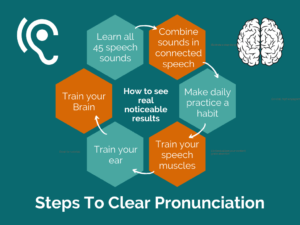
14 Dec How do accent reduction classes work?
Is it possible to change your accent?
Your English pronunciation coach explains how English pronunciation coaching works
English pronunciation training helps non-native English speakers to reduce native language interference. If you’ve ever been asked to repeat yourself in English, a language you speak fluently, you’ll know how frustrating it can be. It’s infuriating to find out that despite putting years of practice and effort into this lingua franca, the speech sounds and speech patterns of your native tongue are still affecting the way you articulate in English.
The good news is that it is perfectly possible to fix your foreign accent interference. Here are five ways in which an English pronunciation coach can help you to improve your English pronunciation permanently. Here’s how accent reduction training works…
Step 1: Mapping your accent as a first step to accent reduction
To know where native language interference is coming from, you may want to work with an English pronunciation coach to map out your current accent when you speak English. Book an assessment at British Accent Academy and your coach will listen to your speech and give you exercises across three main areas: your usage of speech sounds, your usage of connected speech (linking, joining, etc.), and your usage of prosody (pitch and pacing).
Your English pronunciation coach will then create a course plan for you and give you exercises to learn. Your accent reduction class will end with recommendations for how to improve using the online self-paced courses and e-books available on the British Accent Academy website.

Step 2: Learning the speech sounds using a British accent model
British Accent Academy uses Modern Received Pronunciation or Standard Southern British English as an accent model for its pronunciation training courses. There are approximately 44 phonemes in British Received Pronunciation and we also teach allophones (variants) of these phonemes. Phonemes are the speech sounds that form the building blocks of spoken language.
Your native language may have overlapping phonemes but the speech sounds in your native language are likely affecting the way you are pronouncing English. You may need to learn new mouth shapes to pronounce words and phrases correctly in Modern Received Pronunciation.
Your English pronunciation coach will be able to help you shape your mouth correctly, using real-life example sentence drills and minimal pair exercises (exercises where pairs of words differ by only one speech sound and where there is a meaning difference) to ensure that you are distinguishing clearly between different phonemes that are contrastive for English native speakers.
Your online modules will allow you ample time to practice sentences containing the phonemes you are mispronouncing and you will be able to check your articulation in the mirror, in front of your coach, and independently to ensure that you are replicating the mouth shapes of Modern Received Pronunciation correctly. You will receive live feedback from your coach in private coaching sessions as well as during live pronunciation workshops and you will learn how to self-correct through the tools that you will be trained to use in the self-paced courses and during your coaching hours. You will also be able to use your animated practice videos and your interactive IPA chart to train your ear to perceive the difference between phonemes that are contrastive in English.
Step 3: Bathroom mirror English phonology practice
Each week, you will use your smart target worksheets to focus your practice on a particular topic and track your progress over several weeks. You will have a word list from your e-book page to use in your training and you will get yourself in front of the mirror two to three times per day to practice your example words and work on developing your self-correction skills. This way, you will train your ear and your brain to perceive and produce the new speech sounds in context.

Step 4: Making your English sound less choppy and more fluid
If your English sounds choppy, with breaks in between sounds, your coach, your course materials, and your e-book practice exercises (with accompanying audio) will help you to smooth out your speech and sound relaxed and nativelike. You’ll begin to use the phonetic script to examine how native speakers blend and connect sounds in context and, in time, you’ll be able to replicate these speech patterns in your rapidly-improving English accent.
Step 5: Learning the rules and exceptions of English pitch and pacing
Your English pronunciation coach knows exactly what errors you’re making when it comes to placing stress, pacing, and using pitch. You’ll work with your coach and with the intonation and stress materials provided to put an end to your pitch and pacing errors. You’ll learn the rules and exceptions of the rhythm and melody of Modern British Received Pronunciation and you’ll be able to apply them in real life to sound nativelike, clear, and confident every single time you express yourself in English.
All of the tools that you need to develop clear and confident English pronunciation are at your fingertips thanks to the full suite of courses, e-books, audio tracks, coaching offerings, and resources available at British Accent Academy. With daily practice and expert support from your highly experienced English pronunciation coach, you can succeed in achieving your English pronunciation goals for a lifetime of permanently clear and confident English Pronunciation.
It is certainly possible to change your accent. You just need to get yourself a little bit of expert guidance and acquire the right English pronunciation courses to help you reduce your accent.
